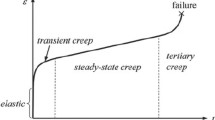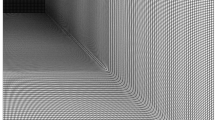Abstract
The engineering stress-strain curve is one of the most convenient characterizations of the constitutive behavior of materials that can be obtained directly from uniaxial experiments. We propose that the engineering stress-strain curve may also be directly converted from the load-depth curve of a deep spherical indentation test via new phenomenological formulations of the effective indentation strain and stress. From extensive forward analyses, explicit relationships are established between the indentation constraint factors and material elastoplastic parameters, and verified numerically by a large set of engineering materials as well as experimentally by parallel laboratory tests and data available in the literature. An iterative reverse analysis procedure is proposed such that the uniaxial engineering stress-strain curve of an unknown material (assuming that its elastic modulus is obtained in advance via a separate shallow spherical indentation test or other established methods) can be deduced phenomenologically and approximately from the load-displacement curve of a deep spherical indentation test.
Similar content being viewed by others
References
G.M. Pharr: Measurement of mechanical properties by ultra-low-load indentation. Mater. Sci. Eng., A 253, 151 (1998).
A. Gouldstone, N. Chollacoop, M. Dao, J. Li, A.M. Minor, and Y-L. Shen: Indentation across size scales and disciplines: Recent developments in experimentation and modeling. Acta Mater. 55, 4015 (2007).
M. Zhao, X. Chen, Y. Xiang, J.J. Vlassak, D. Lee, N. Ogasawara, N. Chiba, and Y.X. Gan: Measuring elastoplastic properties of thin films on an elastic substrate using sharp indentation. Acta Mater. 55, 6260 (2007).
J.R. Greer, W.C. Oliver, and W.D. Nix: Size dependence of mechanical properties of gold at the micron scale in the absence of strain gradients. Acta Mater. 53, 1821 (2005).
M. Dao, N. Chollacoop, K.J. VanVliet, T.A. Venkatesh, and S. Suresh: Computational modeling of the forward and reverse problems in instrumented sharp indentation. Acta Mater. 49, 3899 (2001).
Y.T. Cheng and C.M. Cheng: Scaling, dimensional analysis, and indentation measurements. Mater. Sci. Eng., R 44, 91 (2004).
M. Zhao, N. Ogasawara, N. Chiba, and X. Chen: A new approach to measure the elastic-plastic properties of bulk materials using spherical indentation. Acta Mater. 54, 23 (2006).
H. Lee, J.H. Lee, and G.M. Pharr: A numerical approach to spherical indentation techniques for material property evaluation. J. Mech. Phys. Solids 53, 2037 (2005).
N. Huber and C. Tsakmakis: Determination of constitutive properties from spherical indentation data using neural networks. Part I: The case of pure kinematic hardening in plasticity laws. J. Mech. Phys. Solids 47, 1569 (1999).
Y.P. Cao and J. Lu: A new method to extract the plastic properties of metal materials from an instrumented spherical indentation loading curve. Acta Mater. 52, 4023 (2004).
Y.T. Cheng and C.M. Cheng: Scaling relationships in conical indentation of elastic-perfectly plastic solids. Int. J. Solids Struct. 36, 1231 (1999).
N. Chollacoop, M. Dao, and S. Suresh: Depth-sensing instrumented indentation with dual sharp indenters. Acta Mater. 51, 3713 (2003).
Y.T. Cheng and C.M. Cheng: Can stress-strain relationships be obtained from indentation curves using conical and pyramidal indenters? J. Mater. Res. 14, 3493 (1999).
X. Chen, N. Ogasawara, M. Zhao, and N. Chiba: On the uniqueness of measuring elastoplastic properties from indentation: The indistinguishable mystical materials. J. Mech. Phys. Solids 55, 1618 (2007).
D. Tabor: A simple theory of static and dynamic hardness. Proc. R. Soc. London. Ser. A 192, 247 (1948).
E.G. Herbert, G.M. Pharr, W.C. Oliver, B.N. Lucas, and J.L. Hay: On the measurement of stress-strain curves by spherical indentation. Thin Solid Films 398, 331 (2001).
S.R. Kalidindi and S. Pathak: Determination of the effective zero-point and the extraction of spherical nanoindentation stress-strain curves. Acta Mater. 56, 3523 (2008).
M. Beghini, L. Bertini, and V. Fontanari: Evaluation of the stress-strain curve of metallic materials by spherical indentation. Int. J. Solids Struct. 43, 2441 (2006).
S. Jayaraman, G.T. Hahn, W.C. Oliver, C.A. Rubin, and P.C. Bastias: Determination of monotonic stress-strain curve of hard materials from ultra-low-load indentation tests. Int. J. Solids Struct. 35, 365 (1998).
B. Taljat, T. Zacharia, and F. Kosel: New analytical procedure to determine stress-strain curve from spherical indentation data. Int. J. Solids Struct. 35, 4411 (1998).
S.D. Mesarovic and N.A. Fleck: Spherical indentation of elastic-plastic solids. Proc. R. Soc. London. Ser. A 455, 2707 (1999).
S. Qu, Y. Huang, G.M. Pharr, and K.C. Hwang: The indentation size effect in the spherical indentation of iridium: A study via the conventional theory of mechanism-based strain gradient plasticity. Int. J. Plast. 22, 1265 (2006).
G. Feng, S. Qu, Y. Huang, and W.D. Nix: An analytical expression for the stress field around an elastoplastic indentation/contact. Acta Mater. 55, 2929 (2007).
A.C. Fischer-Cripps: Use of combined elastic modulus in the analysis of depth-sensing indentation data. J. Mater. Res. 16, 3050 (2001).
W.C. Oliver and G.M. Pharr: An improved technique for determining hardness and elastic modulus using load and displacement sensing indentation experiments. J. Mater. Res. 7, 1564 (1992).
B. Taljat and G.M. Pharr: Development of pile-up during spherical indentation of elastic-plastic solids. Int. J. Solids Struct. 41, 3891 (2004).
J.R. Matthews: Indentation hardness and hot pressing. Acta Metall. 28, 311 (1980)
R. Hill, B. Storakers, and A.B. Zdunek: A theoretical study of the Brinell hardness test. Proc. R. Soc. London, Ser. A 436, 301 (1989).
Y. Tirupataiah: On the constraint factor associated with the indentation of work-hardening materials with a spherical ball. Metall. Trans. A 11, 2375 (1991).
J.S. Field and M.V. Swain: Determining the mechanical properties of small volumes of material from submicrometer spherical indentations. J. Mater. Res. 10, 101 (1995).
I.N. Sneddon: The relationship between load and penetration in the axisymmetric Boussinesq problem for a punch of arbitrary profile. Int. J. En?. Sci. 3, 47 (1965).
D. Tabor: Hardness of Metals (Oxford University Press, Oxford, UK, 1951).
H.A. Francis: Phenomenological analysis of plastic spherical indentation. J. Em. Mater. Technol. Trans. ASME 98, 272 (1976).
H. Habbab, B.G. Mellor, and S. Syngellakis: Post-yield characterisation of metals with significant pile-up through spherical indentations. Acta Mater. 54, 1965 (2006).
F.M. Haggag, R.K. Nanstad, J.T. Hutton, D.L. Thomas, and R.L. Swain: Use of automated ball indentation testing to measure flow properties and estimate fracture toughness in metallic materials, in Applications of Automation Technology to Fatigue and Fracture Testing, edited by A.A. Braun, N.E. Ashbaugh, and F.M. Smith (ASTM, Philadelphia, PA, 1990), pp. 188–208.
K.L. Johnson: The correlation of indentation experiments. J. Mech. Phys. Solids 18, 115 (1970).
J.H. Ahn and D. Kwon: Derivation of plastic stress-strain relationship from ball indentations: Examination of strain definition and pileup effect. J. Mater. Res. 16, 3170 (2001).
F.P. Bowden and D. Tabor: The Friction and Lubrications of Solids (Oxford University Press, Oxford, UK, 1950).
Y.P. Cao, X. Qian, and N. Huber: Spherical indentation into elastoplastic materials: Indentation-response based definitions of the representative strain. Mater. Sci. Eng..A 454-455, 1 (2007).
J.H. Lee, T. Kim, and H. Lee: A study on robust indentation techniques to evaluate elastic-plastic properties of metals. Int. J. Solids Struct. 47, 647 (2010).
K.S. Zhang and Z.H. Li: Numerical analysis of the stress-strain curve and fracture initiation for ductile material. Ens. Fract. Mech. 49, 235 (1994).
W.C. Oliver and G.M. Pharr: Measurement of hardness and elastic modulus by instrumented indentation: Advances in understanding and refinements to methodology. J. Mater. Res. 19, 3 (2004).
A.L. Norbury and T. Samuel: The recovery and sinking-in or piling-up of material in the brinell test, and the effects of these factors on the correlation of the brinell with certain other hardness tests. J. Iron Steel Inst. 17, 673 (1928).
M.F. Ashby: Materials Selection in Mechanical Design, 2nd ed. (Butterworth-Heinemann, Woburn, MA, 1999).
Author information
Authors and Affiliations
Corresponding author
Rights and permissions
About this article
Cite this article
Xu, B., Chen, X. Determining engineering stress-strain curve directly from the load-depth curve of spherical indentation test. Journal of Materials Research 25, 2297–2307 (2010). https://doi.org/10.1557/jmr.2010.0310
Received:
Accepted:
Published:
Issue Date:
DOI: https://doi.org/10.1557/jmr.2010.0310




